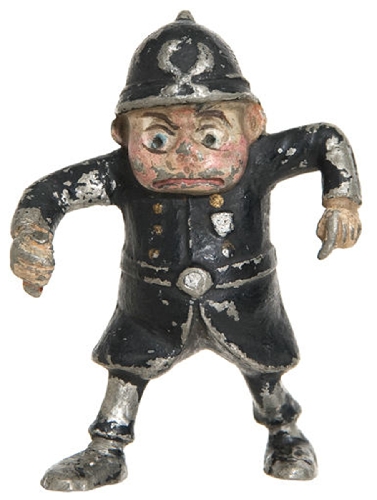Brownies: Fun for children, satire for adults

The Brownies, drawn by Palmer Cox, are almost unknown to anyone younger than 80 today, but they were favorites of children from 1883 into the 1930s. The Brownies were tiny fairies, all male, who each night cleaned and fixed things for humans –Â that is, if they weren’t exploring or playing tricks.
Cox first wrote and illustrated the Brownies’ activities in magazines, then in books, advertisements, toys, games, costumes, fabrics, china, jewelry and silver. But the Brownie name is best known because in 1900 Kodak decided to use the name and images of the Brownies to promote its new camera. The Kodak Brownie remained a popular camera until 1967.
Few collectors realize that Brownies provided not just fun for children, but also sly political satire for adults. The Brownie “400” referred to the elite 400 of New York City. The Brownies “Policeman” and “Jockey” both represented real people.
Brownie memorabilia easily is found today because many companies used the images without getting permission. Cox finally was able to obtain a copyright in 1891, and then licensed his work for a fee. His idea of licensing led the way for other artists to profit from their work.
Q: My grandmother gave me a fancy easel-back mirror that belonged to her mother. It always sat on her dresser. The frame is surrounded by molded curlicues, but I can’t tell if they’re made of wood or papier-mâché. Printed at the top of the back of the mirror in black ink is “Syracuse Ornamental Co., Inc.” What can you tell me about this company?
A: Syracuse Ornamental Co. was founded in Syracuse, N.Y., in the late 1890s by Adolph Holstein, an Austrian immigrant and woodcarver. At first the company made carved wooden decorations that were used to embellish furniture, coffins and housing interiors.
In the 1930s, the company introduced a special mixture of wood powders, waxes and resins called “Syroco” or “Syrocco” (a combination of the first letters of each word of the company’s name). The company was able to make molds of its carved wooden decorations, and mass-produced replicas using compression molding and the new mixture.
Your mirror is one of the earlier pieces made with this mixture, since the corporate name was changed to Syroco, Inc., sometime around 1940. We have seen mirrors like yours offered for $100 online.
Syroco, Inc., closed in 2007.
Q: I have a set of 12 plates marked “Copeland Spode, England, Plummer Ltd., 7 & 9 East 35th St., New York.” The word “Spode” is in a rectangle set over a square. The plates are white with a shell-embossed rim and a thin green border. Each one has a different center scene of two women, many showing them at a piano. There’s a year printed under each scene, too, ranging from 1800 to 1910. Can you tell me anything about the plates?
A: Your plates were made in the 20th century by W.T. Copeland & Sons of England. Plummer Ltd. was the New York City retail store that sold the set. The mark on your set was used starting after World War I, and Plummer closed in 1962. So that narrows down the age of your plates to 50-90 years.
The years printed on the front of your plates refer to the era of the scene on each plate.
Q: Is my Miller clock a collector’s item? It looks as if it was made in the 1950s.
A: There are two men named Miller who are of interest to 20th-century clock collectors. Herman Miller was a clockmaker who started the Star Furniture Co. in Zeeland, Mich., in 1905. The company name was changed to Herman Miller Furniture Co. in 1923. It made the then-popular revival styles of furniture. But in 1930, the company hired Gilbert Rohde (1894-1944). He designed modern furniture and clocks for Miller. When Rohde died, George Nelson (1908-1986) did the designing.
The Howard Miller Clock Co. was founded in 1926 by Herman’s son, Howard. It originally was called the Herman Miller Clock Co., but during the Depression it became the Howard Miller Clock Co., a firm that still is making clocks. George Nelson designed many of Howard Miller’s modern 1940s and ’50s clocks. The famous Nelson “Ball clock” looks like it has rays made from Tinkertoys.
Nelson’s clocks, like ’50s furniture designs, are popular again and are being reproduced.
Q: I have six wooden dining chairs that have unattractive upholstered seats. I took the fabric off one chair and discovered it had a tin bottom in it. The bottom is stamped “Pat. Dec. 3 1871 H. Closterman Cincinnati O.” I paid $10 apiece for them with the intention of putting new seats on them. Now my husband says we should leave them alone and see what we can find out about them.
A: H. Closterman & Co. was established in Cincinnati in 1843. The company made chairs, parlor furniture, beds, desks and other furniture. Henry Closterman and his son, Henry Closterman Jr., held several furniture patents. The factory was destroyed by fire in 1881. The senior Mr. Closterman died in 1918 at age 96. His obituary mentions that although he was a wealthy man, he could not read or write, and his will was signed with an X.
His chairs sell for about $100 each.
Terry Kovel’s column is syndicated by King Features. Write to: Kovels, (Las Vegas Review-Journal), King Features Syndicate, 300 W. 57th St., New York, NY 10019.












